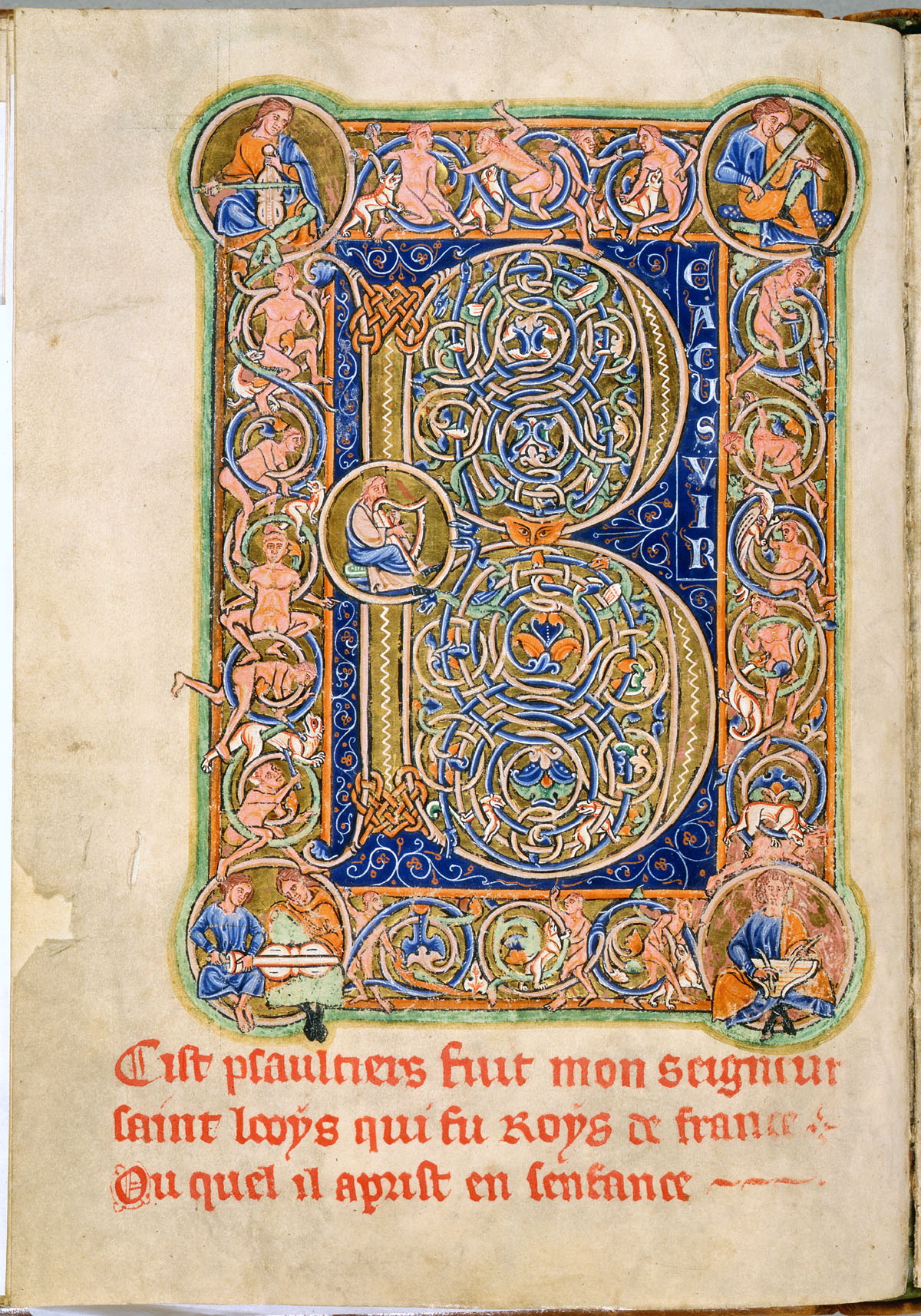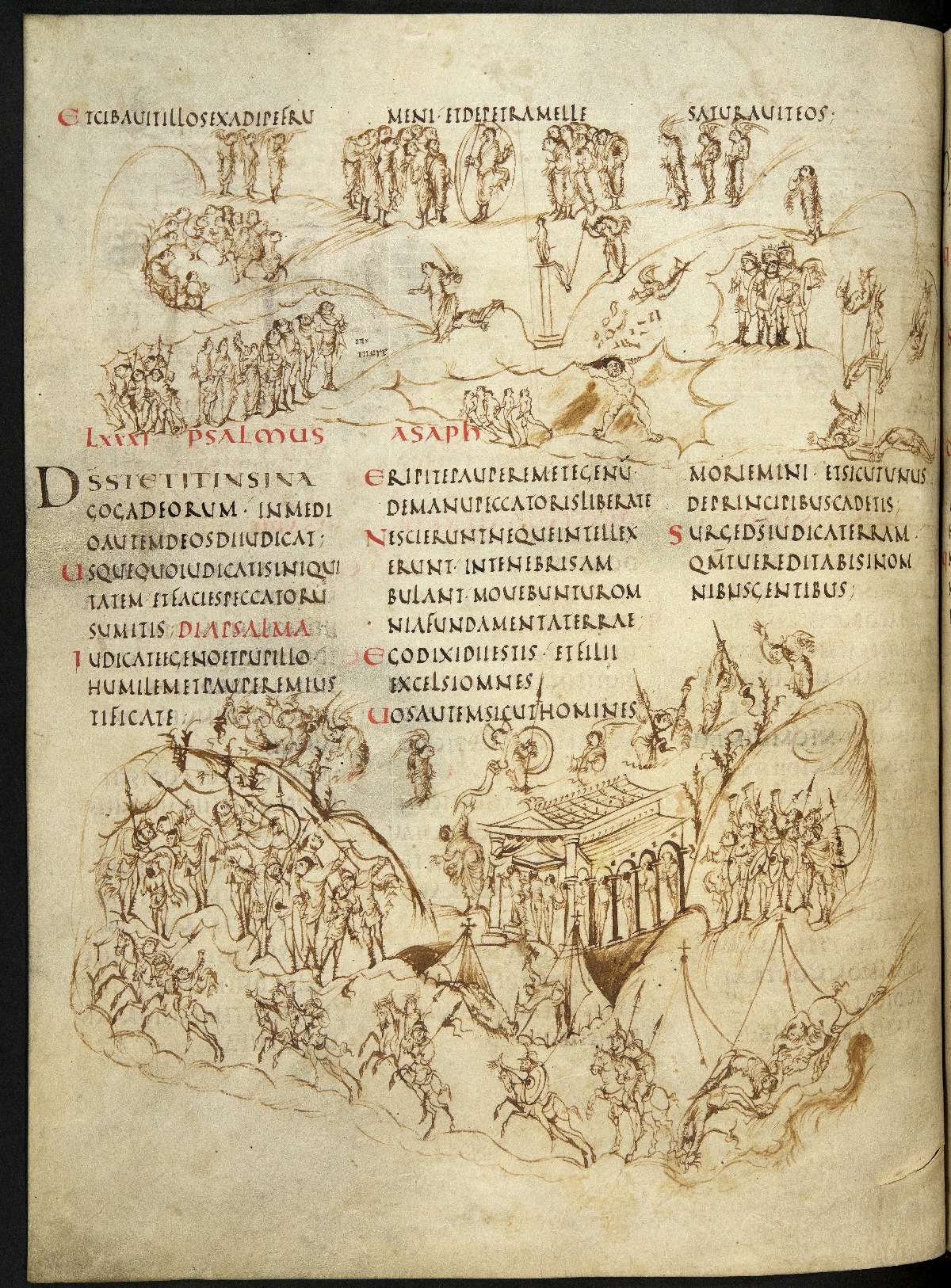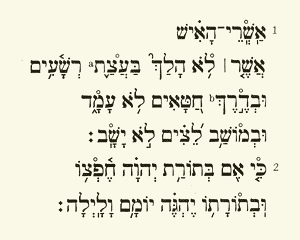|
Psalters
A psalter is a volume containing the Book of Psalms, often with other devotional material bound in as well, such as a liturgical calendar and litany of the Saints. Until the emergence of the book of hours in the Late Middle Ages, psalters were the books most widely owned by wealthy lay persons. They were commonly used for learning to read. Many Psalters were richly illuminated, and they include some of the most spectacular surviving examples of medieval book art. The English term (Old English , ) derives from Church Latin. The source term is la, psalterium, which is simply the name of the Book of Psalms (in secular Latin, it is the term for a stringed instrument, from grc, ψαλτήριον ''psalterion''). The Book of Psalms contains the bulk of the Divine Office of the Roman Catholic Church. The other books associated with it were the Lectionary, the Antiphonary, and Responsoriale, and the Hymnary. In Late Modern English, ''psalter'' has mostly ceased to refer to the Boo ... [...More Info...] [...Related Items...] OR: [Wikipedia] [Google] [Baidu] |
Latin Psalters
The Latin Psalters are the translations of the Book of Psalms into the Latin language. They are the premier liturgical resource used in the Liturgy of the Hours of the Latin Rites of the Roman Catholic Church. These translations are typically placed in a separate volume or a section of the breviary called the psalter, in which the psalms are arranged to be prayed at the canonical hours of the day. In the Middle Ages, psalters were often lavish illuminated manuscripts, and in the Romanesque and early Gothic period were the type of book most often chosen to be richly illuminated. Versions The Latin Church has a diverse selection of more or less different full translations of the psalms. Three of these translations, the ''Romana'', ''Gallicana'', and ''juxta Hebraicum'', have been traditionally ascribed to Jerome, the author of the Latin Vulgate; however, the ''Romana'' has not been produced by Jerome. Two other translations, the Pian and Nova Vulgata versions, were made in the 20 ... [...More Info...] [...Related Items...] OR: [Wikipedia] [Google] [Baidu] |
Utrecht Psalter
The Utrecht Psalter (Utrecht, Universiteitsbibliotheek, MS Bibl. Rhenotraiectinae I Nr 32.) is a ninth-century illuminated manuscript, illuminated psalter which is a key masterpiece of Carolingian art; it is probably the most valuable manuscript in the Netherlands. It is famous for its 166 lively pen illustrations, with one accompanying each psalm and the other texts in the manuscript (Chazelle, 1055). The precise purpose of these illustrations, and the extent of their dependence on earlier models, have been matters of art-historical controversy. The psalter spent the period between about 1000 to 1640 in England, where it had a profound influence on Anglo-Saxon art, giving rise to what is known as the "Utrecht style". It was copied at least three times in the Middle Ages. A complete facsimile edition of the psalter was made in 1875 (Lowe, 237), and another in 1984 (Graz). The other texts in the book include some canticles and hymns used in the Liturgy of the Hours, office of the ... [...More Info...] [...Related Items...] OR: [Wikipedia] [Google] [Baidu] |
Beatus Initial
Beatus vir (; "Blessed is the man...") are the first words in the Latin Vulgate Bible of both Psalm 1 and Psalm 112 (in the general modern numbering; it is Psalm 111 in the Greek Septuagint and the Vulgate). In each case, the words are used to refer to frequent and significant uses of these psalms in art, although the two psalms are prominent in different fields, art in the case of Psalm 1 and music in the case of Psalm 112. In psalter manuscripts, the initial letter B of Beatus is often rendered prominently as a Beatus initial. Altogether the phrase occurs 14 times in the Vulgate text, eight times in the Book of Psalms, and four times in the rest of the Old Testament, but no uses in the New Testament. Psalm 1 in art Psalm 1 naturally begins the text of the Book of Psalms. In illuminated manuscript psalters this start was traditionally marked by a large Beatus initial for the B of Beatus, and the two opening words are often much larger than the rest of the text. Between them t ... [...More Info...] [...Related Items...] OR: [Wikipedia] [Google] [Baidu] |
Antiphonary
An antiphonary or antiphonal is one of the liturgical books intended for use (i.e. in the liturgical choir), and originally characterized, as its name implies, by the assignment to it principally of the antiphons used in various parts of the Latin liturgical rites. Medieval antiphonaries varied with regional liturgical tradition. In 1570, following the Council of Trent, the Roman Rite antiphonary was declared universal. The Roman Antiphonary (''Antiphonale Romanum'') contains the chants for the canonical hours for the hours of Lauds, Prime, Terce, Sext, None, Vespers and Compline for every day of the year. The ''Vesperale Romanum'' is an excerpt of the Antiphonary containing the chants sung at Vespers. The music for use at the Mass is contained in the Roman Gradual (''Graduale Romanum''), the chants of the ordinary are also edited as an excerpt from the Gradual, the ''Kyriale Romanum''. The ''Antiphonale Romanum'' was substantially revised in 1910–11 in the course of th ... [...More Info...] [...Related Items...] OR: [Wikipedia] [Google] [Baidu] |
Francia
Francia, also called the Kingdom of the Franks ( la, Regnum Francorum), Frankish Kingdom, Frankland or Frankish Empire ( la, Imperium Francorum), was the largest post-Roman barbarian kingdom in Western Europe. It was ruled by the Franks during late antiquity and the Early Middle Ages. After the Treaty of Verdun in 843, West Francia became the predecessor of France, and East Francia became that of Germany. Francia was among the last surviving Germanic kingdoms from the Migration Period era before its partition in 843. The core Frankish territories inside the former Western Roman Empire were close to the Rhine and Meuse rivers in the north. After a period where small kingdoms interacted with the remaining Gallo-Roman institutions to their south, a single kingdom uniting them was founded by Clovis I who was crowned King of the Franks in 496. His dynasty, the Merovingian dynasty, was eventually replaced by the Carolingian dynasty. Under the nearly continuous campaigns of Pep ... [...More Info...] [...Related Items...] OR: [Wikipedia] [Google] [Baidu] |
Historiated Initial
A historiated initial is an initial, an enlarged letter at the beginning of a paragraph or other section of text, that contains a picture. Strictly speaking, a historiated initial depicts an identifiable figure or a specific scene, while an inhabited initial contains figures (human or animal) that are decorative only, without forming a subject. Both sorts became very common and elaborate in luxury illuminated manuscripts. These illustrated initials were first seen in the Insular art of the early 8th century. The earliest known example is in the Saint Petersburg Bede, an Insular manuscript of 731–46, and the Vespasian Psalter has another. The size and decoration of the initial further gives clues to both its importance and location. Letters that began a new section of a text or a particularly noteworthy section might receive more flourishes and space. They would also provide a visual point of reference, "marking the division of the text into books, chapters, paragraphs and som ... [...More Info...] [...Related Items...] OR: [Wikipedia] [Google] [Baidu] |
Psalm 1
Psalm 1 is the first psalm of the Book of Psalms, beginning in the English King James Version: "Blessed is the man", and forming "an appropriate prologue" to the whole collection.Kirkpatrick, A. F. (1906)Cambridge Bible for Schools and Collegeson Psalm 1, accessed 11 September 2021 The Book of Psalms is part of the third section of the Hebrew Bible, and a book of the Christian Old Testament. In Latin, this psalm is known as Beatus vir or ''Beatus vir, qui non abiit''.Church of EnglandBook of Common Prayer: The Psalteras printed by John Baskerville in 1762 The psalm is a regular part of Jewish, Catholic, Lutheran, Anglican, and other Protestant liturgies. Text Hebrew Bible version Following is the Hebrew text of Psalm 1: King James Version # Blessed is the man that walketh not in the counsel of the ungodly, nor standeth in the way of sinners, nor sitteth in the seat of the scornful. # But his delight is in the law of the ; and in his law doth he meditate day and night. # ... [...More Info...] [...Related Items...] OR: [Wikipedia] [Google] [Baidu] |
New Testament
The New Testament grc, Ἡ Καινὴ Διαθήκη, transl. ; la, Novum Testamentum. (NT) is the second division of the Christian biblical canon. It discusses the teachings and person of Jesus, as well as events in first-century Christianity. The New Testament's background, the first division of the Christian Bible, is called the Old Testament, which is based primarily upon the Hebrew Bible; together they are regarded as sacred scripture by Christians. The New Testament is a collection of Christian texts originally written in the Koine Greek language, at different times by various authors. While the Old Testament canon varies somewhat between different Christian denominations, the 27-book canon of the New Testament has been almost universally recognized within Christianity since at least Late Antiquity. Thus, in almost all Christian traditions today, the New Testament consists of 27 books: * 4 canonical gospels (Matthew, Mark, Luke, and John) * The Acts of the Apostl ... [...More Info...] [...Related Items...] OR: [Wikipedia] [Google] [Baidu] |
Old Testament
The Old Testament (often abbreviated OT) is the first division of the Christian biblical canon, which is based primarily upon the 24 books of the Hebrew Bible or Tanakh, a collection of ancient religious Hebrew writings by the Israelites. The second division of Christian Bibles is the New Testament, written in the Koine Greek language. The Old Testament consists of many distinct books by various authors produced over a period of centuries. Christians traditionally divide the Old Testament into four sections: the first five books or Pentateuch (corresponds to the Jewish Torah); the history books telling the history of the Israelites, from their conquest of Canaan to their defeat and exile in Babylon; the poetic and " Wisdom books" dealing, in various forms, with questions of good and evil in the world; and the books of the biblical prophets, warning of the consequences of turning away from God. The books that compose the Old Testament canon and their order and names differ b ... [...More Info...] [...Related Items...] OR: [Wikipedia] [Google] [Baidu] |
Canticle
A canticle (from the Latin ''canticulum'', a diminutive of ''canticum'', "song") is a hymn, psalm or other Christianity, Christian song of praise with lyrics usually taken from biblical or holy texts. Canticles are used in Christian liturgy. Catholic Church Prior to the Pope Pius X's Reform of the Roman Breviary by Pope Pius X, 1911 reforms, a single cycle of seven canticles was used at Lauds: * Sunday – The Song of the Three Holy Children () * Monday – The Song of Isaiah the Prophet () * Tuesday – The Song of Hezekiah () * Wednesday – The Song of Hannah () * Thursday – The (First) Song of the sea, Song of Moses () * Friday – The Prayer of Habakkuk () * Saturday – The (Second) Song of Moses () These canticles are rather long, and the weekday ones display something of a penitential theme, but some were not often used, as all feasts, and weekdays in Eastertide used the Canticle of Daniel, the Sunday canticle. The 1911 reform introduced for weekdays not of penitenti ... [...More Info...] [...Related Items...] OR: [Wikipedia] [Google] [Baidu] |
Liturgy
Liturgy is the customary public ritual of worship performed by a religious group. ''Liturgy'' can also be used to refer specifically to public worship by Christians. As a religious phenomenon, liturgy represents a communal response to and participation in the sacred through activities reflecting praise, thanksgiving, remembrance, supplication, or repentance. It forms a basis for establishing a relationship with God. Technically speaking, liturgy forms a subset of ritual. The word ''liturgy'', sometimes equated in English as " service", refers to a formal ritual enacted by those who understand themselves to be participating in an action with the divine. Etymology The word ''liturgy'' (), derived from the technical term in ancient Greek ( el, λειτουργία), ''leitourgia'', which literally means "work for the people" is a literal translation of the two words "litos ergos" or "public service". In origin, it signified the often expensive offerings wealthy Greeks made in ser ... [...More Info...] [...Related Items...] OR: [Wikipedia] [Google] [Baidu] |









